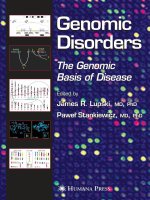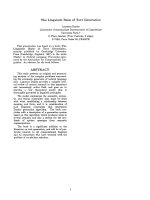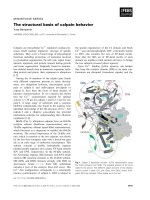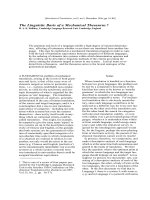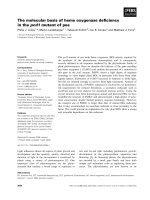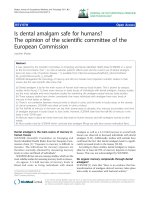THE SCIENTIFIC BASIS OF MATURATION CULTURE AND TECHNOLOGY OF WHISKER CATFISH REPRODUCTION (micronema bleekeri)
Bạn đang xem bản rút gọn của tài liệu. Xem và tải ngay bản đầy đủ của tài liệu tại đây (371.11 KB, 27 trang )
MINISTRY OF EDUCATION AND TRAINING
CAN THO UNIVERSITY
♣♣♣
NGUYEN VAN TRIEU
THE SCIENTIFIC BASIS OF
MATURATION CULTURE AND
TECHNOLOGY OF WHISKER CATFISH
REPRODUCTION (Micronema bleekeri)
Specialization: Freshwater Aquaculture
Field of Study Code: 62 62 60 01
Dissertation of Doctor Degree in Aquaculture
Cantho, 2014
The study was carried-out at: College of Aquaculture and Fisheries,
Can Tho University.
Supervisors:
Ass/Prof. Dr. Nguyen Anh Tuan
Ass/Prof. Dr. Duong Nhut Long
Examiner 1:
Examiner 2:
The dissertation will be defended at the university committee in …
at: ….… hr ….… date ……. month ……. year 2014
The disseratation is available in Libraries:
Learning Resource Center of Can Tho University.
College of Aquaculture, Can Tho University
1
AN OVERVIEW OF THE THESIS
1. Imperative thesis
Fresh water aquaculture which is a position of strength in the
Mekong Delta includes mainly objects such as tra catfish, climbing
perch, snakehead,… However, in recent years, aquaculture has had
difficulties because prices which are not usually stable. Therefore,
farmers have found some new culture species. As assessment of
several farmers both An Giang and Dong Thap provinces that
whisker catfish is a species which has had high economic values and
prospects for developmental aquaculture, especially in cages culture.
Fingerlings which have been depending on nature do not guarantee
quality and quantity. These study results about whisker catfish have
provided basic data about biological characteristics and technology of
artificial reproduction. The contribution of building the process of
whishker catfish reproduction which is: “The scientific basis of
maturation culture and technology of whisker catfish
reproduction (Micronema bleekeri Gunther, 1864)” was carried
out.
2. General objectives of thesis
To provide scientific data about the technology of gonadosomatic
conditioning and whisker catfish reproduction, contributing to
production of fingerlings initiatively both quality and quantity for
farmers, and objecting diversification and sustainable development of
aquaculture in the Mekong Delta.
3. Significance of scientific and reality
In the scientific aspect, these studies have provided scientific
information about the effective feed to martunity of whiker catfish.
Besides, thesis has also studied the capacity of M. bleekeri spawning
by different hormones and technology of whisker catfish rearing from
fry to fingerling stages.
4. New results of thesis: The first in identifing:
Whisker catfish which was conditioned in ponds by trash tiny shrimp
will have been maturity in May and June with gonadosomatic index
2
(about 3.8 ± 0.08%) in females and relative fecundity (about 110 ±
9.1 eggs/g female). Through conditioning process that Vitellogenin
(Vg) in plasma of female will change proportional with the
development stages of gonad. Vg content increased the highest when
gonad has changed from III to IV stage and had closely correlation
between Vg content and the development of egg diameter in times.
Spawning stimulation of M. bleekeri by pituitary with 3.5 mg/kg
female; LRHa + Dom (70 µg) + 3.5 mg/kg female; and Ovaprim
which was used with 0.3 mL/kg so that fish has had spawning,
besides the rates of fecundity, fertilization and hatching was
relatively high. Whereas, spawning stimulation by HCG (4,000 –
6,000 UI/kg female) so that 100 % of fish did not ovulate.
M. bleekeri started first feeding after two days. From 2 to 5 days, fish
was fed by rotifera and copepoda larvae, through 6 – 30 days fish
was fed by Cladocera and Copepoda. The rearing of M. bleekeri by
tubifex with 3.5 individuals/L so that daily weight gain (20.2 ± 0.25
mg/day) and survival rate (88.9 ± 3.2 %) were relatively high.
Whisker catfish was also used well home-made feed at 7
th
day.
Protein requirement of M. bleekeri fingerlings (sizes of fish about
269 mg) was 43.2 %. The rearing of whisker catfish by pellet (36 %
crude protein) with density of 3.5 fingerlings/L at 60 days; which has
achieved survival rate and daily weight gain were 81.2 ± 3.5 % and
25.9 ± 0.25 mg/day, respectively.
THE STUDY METHODS
3.1. The times and location of study
The study was carried out from 2007 to 2011 at the College of
Aquaculture and Fisheries, Can Tho University.
3.2. Study object was whishker catfish Micronema bleekeri
3.3. Study methods
3.3.1. Effective feed to maturity of whisker catfish
3.3.1.1. Experiment systems
3
An experiment was carried out in hapas (1 x 1x 1.5 m), sizes of mesh
was 0.5 cm; which was put in a pond (500 m
2
), the depth of water
was 1.2 – 1.5 m.
3.3.1.2. Fish of experiment: Whisker catfish was equal sizes and
healthy, and the initial weight of fish was 80 – 90 g/fish.
3.3.1.3. Feed of experiment: Trash tiny shrimp and fish, which were
crushed and mixed with 1 % of powder of cotton leaves to increase
adhisively and pelllets were also wetted by water. Feed was put in
”feeding floors” at the bottom of hapas.
3.3.1.4. Experimental design
The experiment including three treatments (T) was completely
randomized designed with three replicates. Every hapa was stocked
with 20 whisker catfish (the rate of male and female was 1 : 1). The
time of experiment was five months.
Table 3.1. Component of home-made feed
Treatment (T)
Component of home-made feed
T 1
99% trash tiny shrimp + 1% kapok powder
T 2
49.5% trash tiny shrimp+49.5% trash fish+1% kapok powder
T 3
100% pellet (29.5 % crude protein)
3.3.1.5. Feeding and taking care of: Whishker catfish was fed
demandably, including two times per day at 8 am and 5 pm.
2.3.1.6. Result records
Before conducting experimental arrangement, three males and
females were chosen contingently to collect the first data. Through
experimental process, recurrently every treatment will have sampled
contingently, including three males and females to check the maturity
of fish through index about the size rates of eggs diameter, the
erythrocyte numbers, hemoglobin and vitellogenin contents. These
indexes were checked at 30; 60; 90; 105; 120 and 150 days after
experimental arrangement. Gonadosomatic index and fecundity of
whishker catfish were checked at the times that gonad of fish was 4
th
stage.
3.3.2. The technological study of artificial spawning of whishker
catfish
4
3.3.2.1. Experimental fish: Healthy whishker catfish with the initial
weight of 50 – 100 g/fish.
Female: big belly, concave papilla. Whishker catfish has had eggs
diameter which was ≥ 0.8 mm was more than 80%.
Male: choosing fish which has had slim body, samll belly and
pointed papilla.
3.3.2.2. Experimental design
Table 3.2: Content of hormone in experimental arrangement
Four experiments were completely randomized designed, with four
different hormones, every type of hormone has had three content (9
females/repeatedly) (Table 3.2). Male fish was injected by hormone
correlatively with each experiment, by 1/3 the content of female.
3.3.2.5. Recording of results: The results of artificial breeding of
whishker catfish were evaluated through some indexes: the rate of
spawning, the times of effective drugs, fecundity, fertilization rates,
and the rates of hatching; which was recorded.
3.3.3. The technological study of whisker catfish rearing from fry
to fingerling stages
3.3.3.1. The study of nutritional characteristics of whisker catfish
from fry to juvenile
a. Experimental pond: The study was carried out in a pond which
has had about 12 m
2
(3 x 4 m) in areas, and was coated canvas and
muds at bottom about 25 cm, the depth of water was 0.5 m.
b. Feed: Before stocking, natural food was cultured by haversacks
which have had about 25 µm in mesh and have contained fish meal
in some corners of ponds throughout experiment, avoiding fish was
eating directly fish meal.
Experiment
Hormone
Content of hormone
I
II
III
1
2
3
4
Hypophysis (mg/kg female)
HCG (UI/kg female)
LRHa (µg) + Dom (mg)/kg female
Ovaprim (ml/kg female)
1.5
4,000
40 + 3.5
0.3
2.5
5,000
70 + 3.5
0.4
3.5
6,000
100 + 3.5
0.5
5
c. Experimental design: Whisker catfish (1 day) which has had
average weight and length were 1.73 mg and 5.02 mm, respectively;
were stocked in the pond about 600 fish/m
2
in density and the
experimental time was 30 days.
d. Sampling and analysis
Sampling: The samplings of zooplankton and phytoplankton and fish
on the day: 1; 2; 3; 4; 5; 6; 8; 10; 15; 20; 25 and 30 after stocking.
Fish was sampled contingently about 30 individuals and preserved in
formol solution 10%.
The analysis of zooplankton and phytoplankton: qualitative analysis
based on classification documents of Dang Ngoc Thanh (1980), Han
Maosen Shu Yunfang (1995); quantify based on the documents of
Duong Tri Dung (1996); Boyd and Tucker (1992).
Identified the nutritional characteristics of whishker catfish
(1) The rate between intestine and standard length L
i
/L
0
(2) Identified the sizes of fish mouth
(3) Stomach analysis
Frequency method: Frequency of food is the rate between stomach
which holds this food and the total of stomachs are observed (Hynes,
1950).
(4) The food choices of fish
Cofficients of food choices are counted by Ivlve’s Electivity index:
E = (r
i
-p
i
)/(r
i
+p
i
)
In there, r
i
which is the percentage of food type i has found in
intestine of fish and p
i
which is the percentage of food type
correlatively has found in environment on the total food which has
had in environment.
3.3.3.2. The study of whisker catfish rearing from fry to
fingerling
Experiment 1: The study of whisker catfish rearing to 30
th
day
using live food
6
a. Experimental design: Experiment was arranged in the system of
plastic bucket about 35 L (held 30 L water). The experiment was
completely randomized designed, including four treatments (T) with
three replicates: (T1) whisker catfish was fed by tubifex, (T2)
whisker catfish was fed by zooplankton, (T3) fish was fed by artemia
and (T4) fish was fed the combination between tubifex and
zooplankton in the same rate.
Fish of experiment was whisker catfish which was two days; healthy,
not deformities and mean weight of fish was 1.8 mg. The density of
rearing was 2.5 fingerlings/L in 30 days.
b. Experimental food: Tubifex is bought by households in Can Tho
province. Zooplankton was cultured (was the same with the culture
method of live food at the study 3.3.3.1. of section b). After that
racket was used to let through for fish which ate gradually through
out the experiment. Larvae of newly-hatched artemia were collected
through the incubation process of cyst artemia about 15 ‰ in salinity
for 24 hours.
e. Feeding and taking care of: Fish was fed by demand, including
two times per day at 8 am and 5 pm.
f. Result records
Environmental factors such as temperature, oxy, pH; which were
identified by 556 YSI – USA, two times per day. Before arranging
experiment, 30 of fry whishker catfish were scaled to indentify the
first weigh. When the experiment has finished, most of fish will have
scaled by electronic weight to identify: daily weigh gain (DWG,
g/ngày), specific growth rate (SGR, %/ngày) and survival rate.
Experiment 2: The study of whisker catfish rearing by Tubifex at
different densities.
a. Experimental arrangment: Experiment fish (2 days) was
arranged contingently in plastic bucket about 35 L (held 30 L water),
including four treatments that densities were 1.5; 3.5; 5.5 and 7.5
individuals/L, respectively, repeated three times. The time of
experiment was 30 days.
7
b. Food of experiment: Food for fish in this experiment was tubifex
which was cut smoothly (the best result in experiment of 1).
Experiment 3: The study of times that whisker catfish has used
effectively home-made feed
a. Experimental design: Experiment was carried out in plastic
bucket about 35 L (held 30 L water). Whisker catfish (2 days) was
arranged in bucket with 2.5 individual/L in density. Experiment was
carried out about 30 days, including six treatments which were
arranged contingently with repeating three times. All treatments
differed by the first day of feeding home-made, including the day 1;
3; 5; 7; 9 and 11 after arranging experiment.
Table 3.5: Nutritional component of home-made feed
Component
% of dry matter
Protein
Lipid
Moisture
Ash
36.1
31.7
10.6
6.89
b. Food of experiment: Components of home-made feed included:
trash fish (100 g), unfatty milk (100g), egg yolk (10 eggs), squid oil
(3%). Most materials were husked, steamed, pressed fiber, dried up
and kept in cold store. Fish was fed three hours per once based on
their demands.
Experiment 4: The study of whisker catfish rearing by pellets at
different densities
a. Experiment systems: Experiment was arranged in cement tanks
with 1 m
3
(held about 600 L water).
b. Fish of experiment: Fish in the experiment was whishker catfish
of 7 days and mean weight was 13.1 mg, weaned by pellets (the
study of 3.3.3.4), healthy and not deformities.
c. Experimental design: Experiment was completely randomized
designed, including four treatments which were 1.5; 3.5; 5.5 and 7.5
individuals/L to equal with 900; 2,100; 3,300 and 4,500 individuals
per tank, respectively and repeated three times. The time period of
the experiment was 60 days.
8
d. Feed and taking care of: Feed of experiment was pellet which
has had 36 % in crude protein.
* Feeding and taking care of: Fish was fed by demand, including
two times per day at 8 am and 5 pm.
* Result records
Environmental factors such as temperature, oxy, pH; which were
identified by 556 YSI – USA, two times per day. Before arranging
experiment, 30 of fry whishker catfish were scaled to indentify the
first weigh. When the experiment has finished, most of fish will have
scaled by electronic weigh to identify: daily weigh gain (DWG,
g/ngày), specific growth rate (SGR, %/ngày) and survival rate.
3.3.3.3. Identify protein requirement of M. bleekeri fingerlings
a. Experimental system: Experiment was carried out in the
composite system (20 L per tank) in door facility and was aerated
continuously.
b. Experimental arrangement: Experiment fish which was 269
mg/fish was weaned home-made feed (by the method which has
achieved in the best results from experiment 3). Experiment was
arranged contingently, including seven treatments, repeated three
times with 2.5 fish/L (30 fish per tank) in six weeks. Most treatments
have had the levels of protein which were 24%; 29%; 34%; 39%;
44%; 49% and 54%, respectively.
c. Food of experiment: Experiment food has had the same of energy
(4.36 Kcal/g) and fatty (10 %). Food materials were fish meal, soya
bean meal, wheat meal, fish oil, vegetable oil, vitamin – mineral,
gelatin and fillers.
Table 3.6. Nutritional component of feed
Component
T 1
T 2
T 3
T 4
T 5
T 6
T 7
Protein (%)
23,94
28,78
33,76
38,94
43,45
48,47
53,73
Lipid (%)
9,38
9,87
9,67
9,63
9,56
9,76
9,84
Carbohydrad (%)
49,0
42,3
35,6
28,8
22,1
15,4
8,72
9
d. Management and taking care of: Diets were about 3 – 7 % of
weight (counted both at demands and dry weight) and fish is fed
every day four times at 7 am, 10.30 am, 2 pm and 5.30 pm.
e. Results records: To identify protein requirement of whisker
catfish fingerlings to record the fish growth; protein demands; feed
conversion ratio, effective protein, survival and herd rates.
3.4. The method of data processing
Data were calculated mean and standard deviation. One-way
ANOVA analysis and DUNCAN test were used to compare
difference among treatments. Data analysis was conducted by using
Statistica 5.0 software.
RESULT AND DISCUSSION
4.1. The conditioning results of whisker catfish maturity
4.1.2. The maturity of whisker catfish
4.1.2.1. The fluctuations of eggs diameter ratio through
conditioning process
In the first time of May (May. 5
th
.2010) eggs of whisker catfish have
had egg diameter which was from 0.3 to 0.4 mm held 33.3 – 40 %,
whereas the rate of egg diameter from 0.5 from 0.7 mm was 50 –
53.3 %, and egg diameter which was ≥ 0.8 mm held very lowly about
6.67 – 13.3%. In June, the rate of egg diameter < 0.4 mm has not
virtually appear in sampling at treatments. Whereas, the percentage
of egg diameter ≥ 0.8 mm which increased sharply at most treatments
were 93.3 %; 83.3 % and 66.7 %, respectively (Figure 4.1).
10
Figure 4.1: The fluctuations of eggs diameter ratio
The highest rate was treatment I (about 93.3 %) and was significantly
higher than the other treatments (p < 0.05). Besides, eggs of whisker
catfish at treatment I have had egg diameter which was ≥ 0.8 mm
held the highest rate (93.3 %); indicating that fish has matured early
and better than the other treatments. These results indicate that trash
tiny shrimp which is an appropriate food for the process of maturity
conditioning of whisker catfish. Fish which has conditioned in ponds
can be mature in May and June.
10/3/2010
0
20
40
60
80
100
<=0,2 0,3-0,4 0,5-0,7 >=0,8
Eggs diameter (mm)
Ratio (%)
T I
T II
T III
25/5/2010
0
20
40
60
80
100
<=0,2 0,3-0,4 0,5-0,7 >=0,8
Eggs diameter (mm)
Ratio (%)
T I
T II
T III
10/4/2010
0
20
40
60
80
100
<=0,2 0,3-0,4 0,5-0,7 >=0,8
Eggs diameter (mm)
Ratio (%)
T I
T II
T III
10/6/2010
0
20
40
60
80
100
<=0,2 0,3-0,4 0,5-0,7 >=0,8
Eggs diameter (mm)
Ratio (%)
T I
T II
T III
10/5/2010
0
20
40
60
80
100
<=0,2 0,3-0,4 0,5-0,7 >=0,8
Eggs diameter (mm)
Ratio (%)
T I
T II
T III
10/7/2010
0
20
40
60
80
100
<=0,2 0,3-0,4 0,5-0,7 >=0,8
Eggs diameter (mm)
Ratio (%)
T I
T II
T III
11
4.1.2.2. The correlation between the sizes of egg diameter (the
maturity stage) and Vitellogenin content (Vg)
0,00
0,50
1,00
1,50
2,00
2,50
3,00
3,50
4,00
10/3/2010 10/4/2010 10/5/2010 25/5/2010 10/6/2010 10/7/2010
Time
Vitellogenin (µg ALP/mg protein)
0,00
0,10
0,20
0,30
0,40
0,50
0,60
0,70
0,80
0,90
1,00
Eggs diameter (mm)
Vg I
Vg II
Vg III
ED I
ED II
ED III
Figure 4.2: The fluctuations of Vg content and average egg diameter
In March, before the experiment had been arranged, whisker catfish
has had egg diameter 0.23 ± 0.08 mm, equal with the gonad of II
stage that Vg content in plasma of fish was about 0.21 ± 0.02 µg
ALP/mg protein. Concurrently with the increasing sharply of egg
diameter (0.5 – 0.52 mm), Vg content in plasma (0.83 -1.03 µg
ALP/mg protein) also increased dramatically. Especially Vg content
rose suddenly (2.46 – 2.65 µg ALP/mg protein) after 15 days. These
results show that, the gonad of fish has developed from III stage (egg
diameter was < 0.4 mm) to IV stage (egg diameter was 0.5 – 0.7 mm)
and Vg content has also increased sharply. In June, egg diameter of
fish at most treatments were ≥0.8 mm. Concomitantly, Vg content
fluctuated from 2.94 to 3.28 µg ALP/mg protein. In July, both egg
diameter and Vg content also decreased sharply and were not
significantly different among treatments (P > 0.05).
4.1.2.3. Effective conditioning food to gonadosomatic index,
fecundity and Vg content of whisker catfish
12
Table 4.4: Gonadosomatic index and Vg content of M. bleekeri
Times
Treat-
ment
Gonadosomatic index (%)
Vg content
(µg ALP/mg protein)
Males
Females
Females
March 10
th
2010
I
0.05 ± 0.01
a
0.23 ± 0.01
a
0.21 ± 0.03
a
II
0.04 ± 0.01
a
0.23 ± 0.01
a
0.21 ± 0.02
a
III
0.04 ± 0.01
a
0.23 ± 0.02
a
0.21 ± 0.02
a
June 10
th
2010
I
0.98 ± 0.21
b
3.80 ± 0.08
d
3.28 ± 0.65
b
II
0.79 ± 0.13
b
3.27 ± 0.29
c
2.94 ± 0.60
b
III
0.81 ± 0.23
b
2.57 ± 0.09
b
3.08 ± 0.58
b
Note: Mean within a column followed by different letters is significantly different at p < 0.05
Before experiment has arranged, gonadosomatic index and Vg
content of M. bleekeri were 0.23 % and 0.21 µg ALP/mg protein,
respectively and not significantly different (p > 0.05) among
treatments. Gonadosomatic index of males was 0.04 – 0.05 %, has
not yet had in Vg content of male. In June, gonadosomatic index and
Vg content of female at most treatments were higher significantly (p
< 0.05) than that in March. Gonadosomatic index of female was
different significantly (p < 0.05) among treatments, whereas Vg
content was not different significantly (p > 0.05) among treatments
(table 4.4). At treatment I, fish which was the highest gonadosomatic
index was about 3.8 ± 0.08 %, next to treatment II which was 3.27 ±
0.29 % was higher significantly (p < 0.05) than that treatment III
(table 4.4). These results show that trash tiny shrimp which is a food
is an appropriateness for conditioning process of M. bleekeri. In June,
gonadosomatic index of male fish fluctuated from 0.79 to 0.98 which
are not significantly different (p > 0.05) among treatments. The
testing shows that in this period, most males fish has matured greatly
(white milk, fully spread and has had semen).
Table 4.5. Fecundity of whisker catfish in June. 10
th
. 2010
Treatment (T)
Relative fecundity (eggs/g female)
T I
T II
T III
110 ± 9.13
c
76.7 ± 3.46
b
72.2 ± 1.47
a
Note: Mean within a column followed by different letters is significantly different at p < 0.05
In June, fecundity of fish which was the significantly highest at
treatment I (110 ± 9.1 eggs/g female) (p < 0.05). Thus, trash tiny
13
shrimp is an appropriate food for the conditioning process of whisker
catfish.
4.2. The effectiveness of types and hormone content to artificial
whisker catfish reproduction
4.2.1. The effectiveness of hypophysis content to the results of
artificial whisker catfish reproduction
Table 4.6: The results of artificial reproduction by hypophysis
Note: Mean within a column followed by different letters is significantly different at p < 0.05
M. bleekeri was stimulated on reproducing about 3.5 mg
hypophysis/kg female (treatment III) which has achieved 115,388 ±
13,487 eggs/kg on fecundity, whereas the rate of fertilization and
hatching were 73.3 ± 6.1 % and 85.4 ± 10.1 %, respectively were
higher significantly than that other treatments (table 4.6).
4.2.2. The effectiveness of HCG content to whisker catfish
reproduction
The results of reproduction by HCG show that fish in all treatments
has not yet ovulated. After fish was injected by HCG from 6 to 8
hours, eggs of fish were checked and measured egg diameter. Egg
diameter was slightly increased.
4.2.3. The effectiveness of LRHa + Dom content to whisker
catfish reproduction
Treat-
ment
Ovulation
rate (%)
Relative fecundity
(eggs/kg)
Fertilization
rate (%)
Hatching
rate (%)
Control
0
-
-
-
I
11.1±9.2
a
22,786 ± 9,467
a
17.3 ± 5.8
a
23.7 ± 4.1
a
II
44.5±8.5
b
65,201 ± 6,799
b
59.3 ± 4.6
b
52.4 ± 7.8
b
III
88.9±9.2
c
115,388 ± 13,487
c
73.3 ± 6.1
c
85.4 ± 10.1
c
14
Table 4.7: The results of reproduction by LRHa + Dom
Treat-
ment
Ovulation
rate (%)
Relative fecundity
(eggs/kg female)
Fertilization
rate (%)
Hatching rate
(%)
Con trol
0
-
-
-
I
100
81,053 ± 14,050
a
61.7 ± 6.94
a
82.3 ± 11.8
a
II
100
188,365 ± 27,843
b
77.7 ± 6.23
b
92.2 ± 4.32
b
III
100
155,934 ± 28,933
b
74.7 ± 6.43
b
73.3 ± 15.1
a
Note: Mean within a column followed by different letters is significantly different at p < 0.05
Table 4.7 shows that ovulation rates at three treatments were 100 % and
relative fecundity fluctuated from 81,053 to 188,365 eggs/kg female. At
treatment II, relative fecundity was the highest (about 188,365 eggs/kg
female) but not significantly different (p > 0.05) from that of treatment III and
was significantly different (p < 0.05) from that of treatment I. The rates of
fertilization and hatching at treatment II were the highest and was higher
significantly (p < 0.05) than other treatments (table 4.7). Thus, the stimulation
of M. bleekeri reproduction by LRHa + Dom which was about 70µg + 3.5mg
was the best effectiveness.
4.2.4. The effects of Ovaprim to reproduce whisker catfish
Table 4.8: The results of artificial reproduction by Ovaprim
Treat-
ment
Ovulation
rate (%)
Relative fecundity
(eggs/kg female)
Fertilization
rate (%)
Hatching
rate (%)
Control
0
-
-
-
I
100
161,773 ± 81,677
a
73.0 ± 5.00
a
91.3 ± 4.08
a
II
100
162,029 ± 72,306
a
71.0 ± 5.29
a
93.8 ± 1.86
a
III
100
160,441 ± 77,937
a
71.0 ± 4.58
a
93.9 ± 5.43
a
Note: Mean within a column followed by different letters is significantly different at p < 0.05
The table 4.8 shows that at three dosages (0.3 mL; 0,4 mL and 0.5
mL/kg female) of Ovaprim have achieved 100 % of ovulation rates.
Relative fecundity of fish fluctuated from 160,441 to 162,029
eggs/kg females. Relative fecundity of whisker catfish at treatment II
which was the highest about 162,029 eggs/kg female) was not
significantly different (p > 0.05) from that of other treatments.
Similarly, the rates of fertilization and hatching at three treatments
were relatively high were not significantly different (p > 0.05). Thus,
the stimulation of M. bleekeri by Ovaprim at dosage of 0.3 mL/kg
female has achieved in high reproduction effects.
15
4.3. The study of technological whisker catfish rearing from fry
to fingerling
4.3.1. The nutritional characteristics of whisker catfish in fry stage
The rate between intestine and standard length: the enteron length of
fish in stages of 2 – 30 days increased slightly. This rate which
fluctuated from 0.311 – 0.361 was lower than 1. Thus, M. bleekeri
has eaten carnivorous in this stage.
The analysis of food in intentine: whisker catfish (02 days) began to
eat first feeding which was zooplankton (100 % of frequency). From 3
rd
day to 5
th
day, the frequencies of rotifera and copepoda were 100 %. To 6
th
day, the addition of Daphnia và Moina were 33.3 % and 26.7 %,
respectively in frequency. To 15
th
day, Naupliius has not yet had in
frequency and Brachionus also decreased to 93.3 %, the instead of
Eucyclops frequency was 20.0 %. In the end of experiment, the
frequency of Brachionus declined to 46.7 % at 30
th
,
whereas Daphnia,
Moina and Eucyclops were 100 % in frequency. (Figure 4.3).
In fish intestin
0
20
40
60
80
100
2 3 4 5 6 8 10 15 20 25 30
Time
Component (%)
Copepoda
Cladocera
Rotifera
Figure 4.3: The components of Zooplankton in fish intestine (r
i
)
The coefficient of food choices: After fish had not been over yolk
sac and beginning to eat the first food, whisker catfish has chosen
16
rotifera and copepoda; which were 0.43 and 0.87, respectively in the
coefficient of food choices. After that, fish has chosen food which
has had the large sizes was more than cladocera in the 6
th
day and
copepoda in the 20
th
day.
4.3.2. The technological study of whisker catfish rearing from fry
to fingerling
4.3.2.1. Experiment 1: The effects of live food to the growth and
survival rate of fish
b. The results of growth in weight of whisker catfish
Table 4.9: Weight growth of fish which was reared by live food
T
First weight
(mg)
Weight after 30
days (mg)
DWG
(mg/day)
SGR
(%/day)
I
1.8
782 ± 2.38
a
26.1 ± 0.45
a
20.2 ± 0.49
a
II
1.8
562 ± 2.56
b
18.7 ± 0.52
b
19.1 ± 0.57
b
III
1.8
542 ± 1.35
b
18.0 ± 0.67
b
19.0 ± 0.35
b
IV
1.8
802 ± 1.58
a
27.4 ± 0.45
a
20.3 ± 0.47
a
Note: Mean within a column followed by different letters is significantly different at p < 0.05
After 30 days, the mean weights and growth of fish at both treatment I
and IV which were relatively the highest were 802 ± 1.58 and 782 ±
2.38 mg/fish; 20.3 and 20.2 %/day, respectively, and were not
significantly different (p > 0.05). The mean weights and growth of fish
at treatment II and III which were lower than that of treatment I and IV
have 562 ± 2.56 and 542 ± 1.35 mg; 19.1 và 19.0%/day, and were not
significantly different (p > 0.05). However, the mean weights, DWG and
SGR of treatment I and IV were more significantly different (p < 0.05)
than that of treatment II and III (table 4.9).
17
c. Survival rate of fish
89,3
80,7
90,7
66,6
0
10
20
30
40
50
60
70
80
90
100
I II III IV
Treatment
(%)
Figure 4.4: Survival rates of whishker catfish after rearing 30 days
After 30 days, survival rate of treatment I, II and IV which were
89.26 %; 80.74 % and 90.74 %, respectively were not significantly
different (p > 0.05). Treatment III (fish was fed by artemia) has
achieved low survival rate (66.6 %), significantly different from that
of other treatments (Figure 4.4). These experiment results show that
tubifex or the combination between tubifex and zooplankton; which
were used to rear whishker catfish to 30
th
day to achieve good results
of growth and survival rate.
4.3.2.2. Experiment 2: The effects of densities to growth and
survival rate of whisker catfish which were reared by tubifex.
b. The results of growth and survival rate
Table 4.10: Growth and survival rate of whiker catfish which
was reared by tubifex
T
First
weight (mg)
Weight after
30 days (mg)
DWG
(mg/day)
SGR
(%/day)
Survival
rate (%)
I
1.8
607 ± 7.0
d
20.2 ± 0.25
d
19.4
± 0.00
b
88.9 ± 3.2
b
II
1.8
560 ± 8.1
c
18.6
± 0.31
c
19.1
± 0.06
ab
83.6 ± 3.1
b
III
1.8
511 ± 10
b
17.0
± 0.35
b
18.8
± 0.06
ab
65.6 ± 4.5
a
IV
1.8
467 ± 41
a
15.5
± 1.35
a
18.5
± 0.30
a
60.7 ± 3.9
a
Note: Mean within a column followed by different letters is significantly different at p < 0.05
18
Table 4.10 shows that daily weight gain (DWG) between treatment I; II;
III and IV which were 20.2 ± 0.25; 18.6 ± 0.31; 17.0 ± 0.35 and 15.5 ±
1.35 mg/day, respectively, were significantly different (p < 0.05) among
treatments. Survival rate of fish at treatment I has achieved 88.9 ± 3.2 %
which was significantly different (p < 0.05) than that of treatment III and
IV, but was not significantly different (p > 0.05) than treatment II (about
83.6 ± 3.1 %) (Figure 4.8). Thus, M. bleekeri was reared by tubifex
(about 30 days) at densities of 3.5 individuals/L which was the most
effective on growth and survival rate.
88,9
b
± 3,2
83,6
b
± 3,1
65,6
a
± 4,5
60,7
a
± 3,9
0
10
20
30
40
50
60
70
80
90
100
1,5 fish/L 3,5 fish/L 5,5 fish/L 7,5 fish/L
Densities
(%)
Figure 4.4: Survival rate of M. bleekeri
4.3.2.3. Experiment 3: Identified the times of M. bleekeri has used
home-made feeds effectively
b. The results of gowth of whishker catfish
There were the significantly different (p < 0.05) in specific growth
rate (SGR) between treatment I and II, were 13.2 and 14.7%/day,
respectively. Wheras SGR at treatment III, IV, V and VI which were
17.56; 17.82; 17.75 and 17.91 %/day were not significantly different
(p > 0.05) and were significantly different (p < 0.05) than other
treatments. The reason is that in the first time, home-made feeds have
not yet had appropriateness for growing up of fish so that whisker
19
catfish ate home-made feeds slightly. However, when fish was
weaned about 5 days (treatment III) which was relative greatly on
DWG was about 13.6 ± 3.21 mg/day (table 4.19).
Table 4.11: The growth results of whishker catfish
T
Time
(day)
First weight
(mg)
Weight after
30 days (mg)
DWG
(mg/day)
SGR
(%/day)
I
1
2.1
110 ± 8.6
a
3.6 ± 0.52
a
13.2 ± 0.21
a
II
3
2.1
172 ± 10.3
b
5.6 ± 1.04
b
14.7 ± 0.08
b
III
5
2.1
407 ± 29.6
c
13.6 ± 3.21
c
17.6 ± 0.12
c
IV
7
2.1
440 ± 15.8
c
14.7 ± 1.31
c
17.8 ± 0.10
c
V
9
2.1
431 ± 20.8
c
14.3 ± 1.45
c
17.8 ± 0.09
c
VI
11
2.1
452 ± 20.6
c
15.1 ± 1.23
c
17.9 ± 0.10
c
Note: Mean within a column followed by different letters is significantly different at p < 0.05
Thus, M. bleekeri may use home-made feeds effectively on 5
th
day
after eating first feeding to equal with the 7
th
day after hatching.
c. Survival rate of fry fish
After 30 days, survival rate of whisker catfish at treatment III (using
home-made feeds on 5
th
day) which was 84.8 ± 3.21 % was not
significantly different (p > 0.05) than that of IV, V and VI. However,
survival rate at treatment III was higher significantly than that of
treatment I and II (figure 4.5). Thus, the times of whisker catifsh which
has used effectively home-made feeds on 5
th
day (on 7
th
after hatching).
20
84,8
11,9
32,2
85,9
80,0
80,7
0
10
20
30
40
50
60
70
80
90
100
I II III IV V VI
Treatment
(%)
Figure 4.5: The survival rate of M. bleekeri which used home-
made feed
4.3.2.4. Experiment 4: The results of M. bleekeri which was
reared by pellets in different densities
b. Growth and survival rate of whisker catfish
Table 4.13: Growth and survival rate of whisker catfish
T
First weight
(mg)
Weight after
60 days (mg)
DWG
(mg/day)
SGR (%/day)
Survival rate
(%)
I
13.1 ± 2.2
1,579 ± 22
b
26.1 ± 0.33
b
7.9 ± 0.02
b
85.4 ± 2.4
a
II
13.1 ± 2.2
1,570 ± 17
b
25.9 ± 0.25
b
7.9 ± 0.02
b
81.2 ± 3.5
a
III
13.1 ± 2.2
1,163 ± 9
a
19.1 ± 0.15
a
7.5 ± 0.01
a
80.1 ± 3.1
a
IV
13.1 ± 2.2
1,120 ± 43
a
18.4 ± 0.75
a
7.4 ± 0.07
a
79.7 ± 5.2
a
Note: Mean within a column followed by different letters is significantly different at p < 0.05
Weight gain (WG), daily weight gain (DWG) and specific growth
rate (SGR) of fish at treatment II (3.5 individuals/L) were 1,570 ± 17
mg; 25.9 ± 1.6 mg/day and 7.98 ± 0.03 %/day; which were not
significantly different (p > 0.05) than that of treatment I and were
higher significantly (p < 0.05) than that of other treatments. Whereas,
DWG and SGR at treatment IV (7.5 individuals/L) which was the
lowest was not significantly different than that of treatment III.
21
Survival rate of fish which was reared by pellets (36 % of crude
protein) at densities of 3.5 individuals/L has achieved 81.2 ± 3.5 %,
and was not significantly different (p > 0.05) than that of other
treatments (table 4.25). These results of growths and survival rates
show that whishker catfish was reared at densities of 3.5
individuals/L by pellets to achieved high effects.
4.3.5. The effects of home-made feeds which has had different
protein to the growth and survival rate of whisker catfish
4.3.5.2. The growth on weight of whisker catfish
Table 4.12: Weigth growth of whisker catfish
T: Food
WG (mg)
DWG (mg/day)
SGR (%/day)
T I: 24
684 ± 11,7
g
16.3 ± 0,28
g
3.01 ± 0,03
g
T II: 29
826 ± 16.8
f
19.7 ± 0.40
f
3.34 ± 0.04
f
T III: 34
1,008 ± 13.7
d
24.0 ± 0.33
d
3.71 ± 0.03
d
T IV: 39
1,193 ± 9.67
c
28.4 ± 0.23
c
4.03 ± 0.02
c
T V: 44
1,499 ± 14.1
b
35.7 ± 0.34
b
4.48 ± 0.02
b
T VI: 49
1,758 ± 11.0
a
41.9 ± 0.26
a
4.81 ± 0.01
a
T VII: 54
860 ± 8.69
e
20.5 ± 0.21
e
3.41 ± 0.02
e
Note: Mean within a column followed by different letters is significantly different at p < 0.05
Weight gain (WG) and specific growth rate of whisker catfish which
were the highest at treatment VI (49 % of crude protein) were 1,758
mg/fish and 4.81 %/day and were significantly different (p < 0.05)
than that other treatments. Growth of fish increased gradually from
treatment I (24 % of crude protein) to treatment VI (49 % of crude
protein). At treatment VII (54 % of crude protein), WG and DWG of
whisker catfish were 860 mg and 20.5 mg/day; which were
significantly higher than that of treatment I and II. However, growth
of fish in this treatment was lower significantly than that of treatment
III; IV; V and VI (table 4.12).
22
Figure 4.11. Protein requirement of M. bleekeri
The results of statistical optimization (the statistical optimization of
linear regression or the equation of quadratic curve of Zeitoun, 1976)
show that protein requuirement of whisker catfish (269 mg/fish) was
43.2 % (figure 4.11).
4.3.5.4 Feed conversion ratio (FCR), Protein effects ratio (PER)
and survival rate of whishker catfish
Fish fed feeds containing (24 % of crude protein had the highest FCR
(2.19), and PCR decreased gradually with the increasing of protein
feeds. The lowest of FCR was 0.85 at treatment of using 49 % of
crude protein. PER declined gradually from 24 to 29 % of crude
protein and increased at treatments 34 and 49 % of crude protein. The
weight comparison of fish shows that at treatment 49 % of crude
protein, PER was 2.39 and weight gain of fish was 2,027 mg/fish
which was more than 2.6 times compared to fish fed 24% protein.
Thus, in this experiment fish fed 49 % of crude protein obtained the
highest growth and better protein utilization compared to the other
treatments.
23
CONCLUSIONS AND RECOMMENDATIONS
5.1. CONCLUSIONS
Whisker catfish were maturation cultured in ponds and fed by trash
tiny shrimp matured greatly in May and June with gonadosomatic
index of females and fecundity of 3.8 ± 0.08 % and 110 ± 9.1 eggs/g
female, respectively. Vitellogenin content in plasma of fish
proportional increased with the development stages of gonad of fish.
Vg content increased the highest when the gonad of fish changed
from III to IV stages. The number of erythrocytes and hemoglobin
contents in blood were not fluctuated sharply throughout the times of
conditioning.
The stimulation of M. bleekeri reproduction by pituitary of 3.5 mg/kg
female; LRHa + Dom with dosage of 70 µg + 3.5 mg/kg female and
Ovaprim with dosage of 0.3 mL/kg female achieved relatively high
spawning rates, fecundity, fertilization, and hatching rates. Whereas,
whisker catfish which were injected by HCG (4,000 – 6,000 UI/kg
female) did not ovulate.
M. bleekeri started the first feedings on 2
nd
day. From 2
nd
day to 5
th
day, fish began to eat rotifera and copepoda, and from 6
th
day to 30
th
day fish ate mainly cladocera. Fish did not choose protozoa and
zooplankton.
Whisker catfish reared by tubifex at densities of 3.5 individuals/L
achieved the highest growth (20.2 ± 0.25 mg/day) and survival rate
(88.9 ± 3.2%).
Whisker catfish could use home-made feeds effectively on 5
th
day
after the first feedings (on 7
th
day). Protein requirement of whisker
catfish (size of 269 mg) were about 43.2 %.
Whisker catfish reared by pellets (36 % of crude protein) at densities
of 3.5 individuals/L in 60 days obtained the highest survival rate
(81.2 ± 3.5 %) and DWG (25.9 ± 0.25 mg/day).
